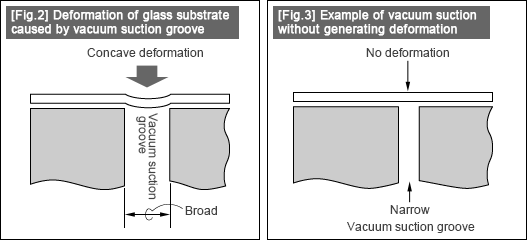#300 Know-how on automation: Workpiece holding-1
General description
If you print patterns or perform various processing while holding the glass substrate onto a work table using vacuum suction, print failures or processing defects are likely to occur at the vacuum suction area.This volume explains the causes and countermeasures.
Explanation
・When printing patterns on a thin glass substrate using various solvents or when processing the substrate mechanically, the vacuum suction method is frequently adopted for holding the glass substrate onto the work table.However, some designs of the vacuum suction groove (such as groove shapes, sizes, and others) may cause processing defects.The following sections describe the relationship between the vacuum suction groove design and the processing defects, and introduce the mechanistic solutions.
(1)Production line
・To work with a thin glass substrate, various processing will be performed on this substrate by attaching the substrate onto a work table using vacuum suction.In this case, the glass substrate should be positioned against the table by aligning its outer periphery with the reference plane of the table. While keeping this alignment, you will place the glass substrate onto the tabletop and keep the substrate in place using vacuum suction.
・In order for this vacuum suction to work with glass substrates of various sizes, the tabletop has various shapes of vacuum suction grooves. (Fig.1)
(2)Causes of processing defects on work table
・Vacuum suction is used to attract the glass substrate placed on the work table and attach it with the tabletop.Since this vacuum suction force is locally absorbed in the vacuum suction groove, when you use a thin glass substrate, the substrate slightly deforms in a concave shape if the vacuum suction groove is too broad.
・This slight concave deformation leads to a localized variation of the print film amount during print processing or causes a curvature in the linear processing work during machining. (Fig.2)
(3)Countermeasures for processing defects caused by vacuum suction holding
・If the vacuum suction groove (width) is too broad compared to the thickness of the glass substrate that is affecting the rigidity, the groove deforms locally due to the vacuum suction force.
・To prevent these failures, the width of this vacuum suction groove should be minimized so that the glass substrate will not deform by the vacuum suction force. (Fig.3)
・The problems can be eradicated by replacing the tabletop materials with ceramics having the porous structure, rather than making changes to the vacuum groove mechanism.
![[Fig.1] Example of substrate suction groove on tabletop [Fig.1] Example of substrate suction groove on tabletop](/tt/en/lca/519_01.gif)

- Positioning technology
- Designing and processing
- Sensor Technology
- Automation elements technology
- Clean room technology
- Design hints
- Design tips
- Designing and Machining
- Drive mechanism design
- Hints on designing
- Linear Motion Components
- Locating Technology
- Manufacturing technology
- Motion mechanism design
- Pneumatic Drives
- Production Technology
- Technology Outlook
- General description
- Low-cost automation and materials
- Transfer LCA
- #333 Know-how on automation: Pressurized heating technology - 5: Multilayer pressurized heating process technique
- #332 Know-how on automation: Pressurized heating technology - 4: Points to remember when designing mechanism of pneumatic pressurization method
- #331 Know-how on automation: Pressurized heating technology - 3: Pneumatic pressurization method and pressure profile
- #330 Know-how on automation: Pressurized heating technology - 2: Pressurization method and pressure profile
- #329 Know-how on automation: Pressurized heating technology



